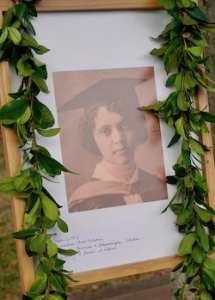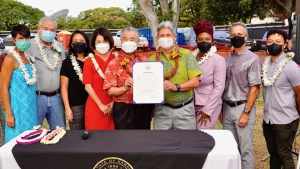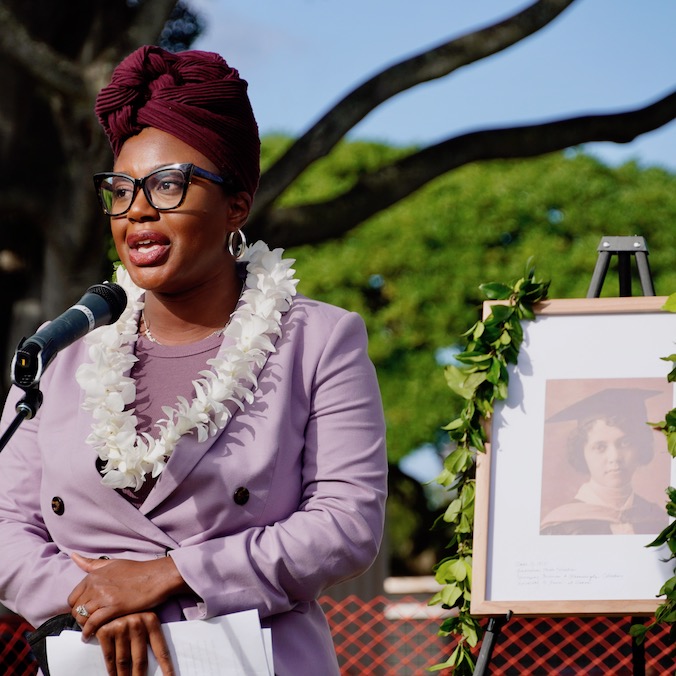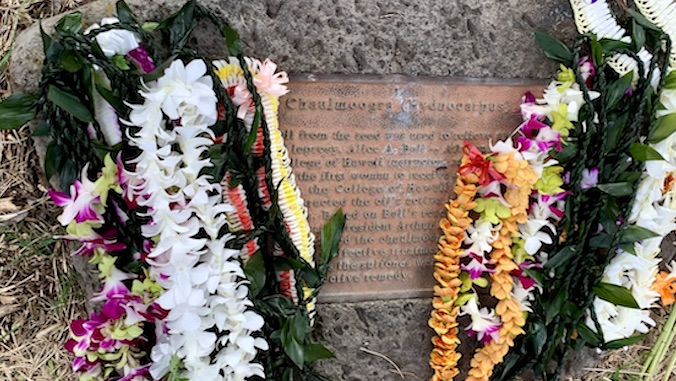Gov. David Ige signed a proclamation that declared February 28 “Alice Augusta Ball Day” in Hawaiʻi at a special recognition ceremony on the University of Hawaiʻi at Mānoa campus on February 28, 2022.

Ball (1892–1916), UH’s first African-American graduate and first woman to earn her master’s degree in chemistry in 1915, was a pioneering scientist who at the age of 23 discovered an effective treatment for Hansen’s disease (leprosy) using oil from the Chaulmoogra tree.
The proclamation signing ceremony took place next to Bachman Hall in the shade of a Chaulmoogra tree planted in Ball’s honor, where a bronze plaque is displayed in her memory. More than 100 people attended, including First Lady Dawn Ige and UH President David Lassner.
“I join the people of Hawaiʻi in paying tribute to this brilliant and inspiring young scientist who did so much for the people of Hawaiʻi and the world,” said Ige.
During the event, Lassner and campus and community members shared comments about Ball and how she has impacted the lives of many, including LaJoya Shelly of UH Mānoa’s Black Student Association, Christine Quemuel with Student Equity Excellence Diversity (SEED), and DeGray Vanderbilt of Ka ʻOhana O Kalaupapa.

“The fact that she made amazing contributions for Hawaiʻi, the world, while here as a young black woman whose work was overlooked for decades—today was just an opportunity to try to begin to make that right,” said Lassner.
Shelly agreed saying it is important for current and future students, especially Black students.
“We know that representation matters and so when we see ourselves written in the academic canon, see ourselves as part of the campus culture, hopefully it enhances our student sense of belonging on campus,” said Shelly.
- Related UH News stories:
- Alice Ball: Cultivating a UH legacy, March 2, 2020
- UH graduate honored alongside Madam Curie and Florence Nightingale, February 4, 2020
- Alice Ball scholarship honors pioneering chemist in fight against Hansen’s disease, February 23, 2017
An accomplished scientist, academic
Much of what is known about Ball is the result of extensive research by Paul Wermager, retired science librarian and former head of Hamilton Library’s science and technology department. A letter from Wermager was read at the event. He is writing a book on Ball and established the Alice Augusta Ball Endowed Scholarship for underrepresented minority students at UH Mānoa who, like Ball, hope to enter the science field.

Ball graduated from UH Mānoa (then the College of Hawaiʻi) in 1915, and her impressive list of firsts grew. She went on to become the school’s first African American female chemistry instructor and department head. Due to her research with kava for her master’s thesis, Ball was recruited by the U.S. Public Health Service (Kalihi Hospital) to use the same technique to find a treatment for Hansen’s disease.
She made the fundamental scientific contribution by applying a new method of isolating ethyl esterification from fatty acids of the chaulmoogra oil so it could be effectively administered to patients by injection.
This isolation technique, later called the “Ball Method,” was the first successful treatment for Hansen’s disease that was used on thousands of patients around the world until the introduction of sulfone drugs in the mid-1940s. The Ball method was used to treat patients in Kalaupapa, permitting them to return to their families after being banished to isolation facilities on the remote Molokaʻi peninsula.
Early death
Sadly, Ball died on December 31, 1916, at the age of 24, before publishing her groundbreaking work. The president of the College of Hawaiʻi, Arthur Dean, continued her work and published her findings, but failed to mention key research she conducted. He mass produced the injectable treatment and was praised for the discovery, calling it the “The Dean Method.” In 1922, Harry T. Hollmann, the doctor at Kalihi Hospital who encouraged Ball to explore chaulmoogra oil, published a paper and attributed her process as the “Ball Method,” giving her the proper credit she deserved.
In 2007, the UH Board of Regents posthumously awarded Alice Ball their Medal of Distinction, for her exceptional accomplishments and significant contributions to the university, state and the world. The medal is on display at UH Mānoa’s Hamilton Library alongside her portrait.
Alice Ball Day in Hawaiʻi had previously been proclaimed in 2000 to be February 29, which falls on Black History Month, after what is now Kalaupapa Month in Hawaiʻi (January) and before Women’s History Month (March).
Read more about Alice Ball on UH News. More on the Alice Augusta Ball Endowed Scholarship.
This recognition of Alice Ball is an example of UH Mānoa’s goal of Excellence in Research: Advancing the Research and Creative Work Enterprise (PDF) and Enhancing Student Success (PDF), two of four goals identified in the 2015–25 Strategic Plan (PDF), updated in December 2020.


